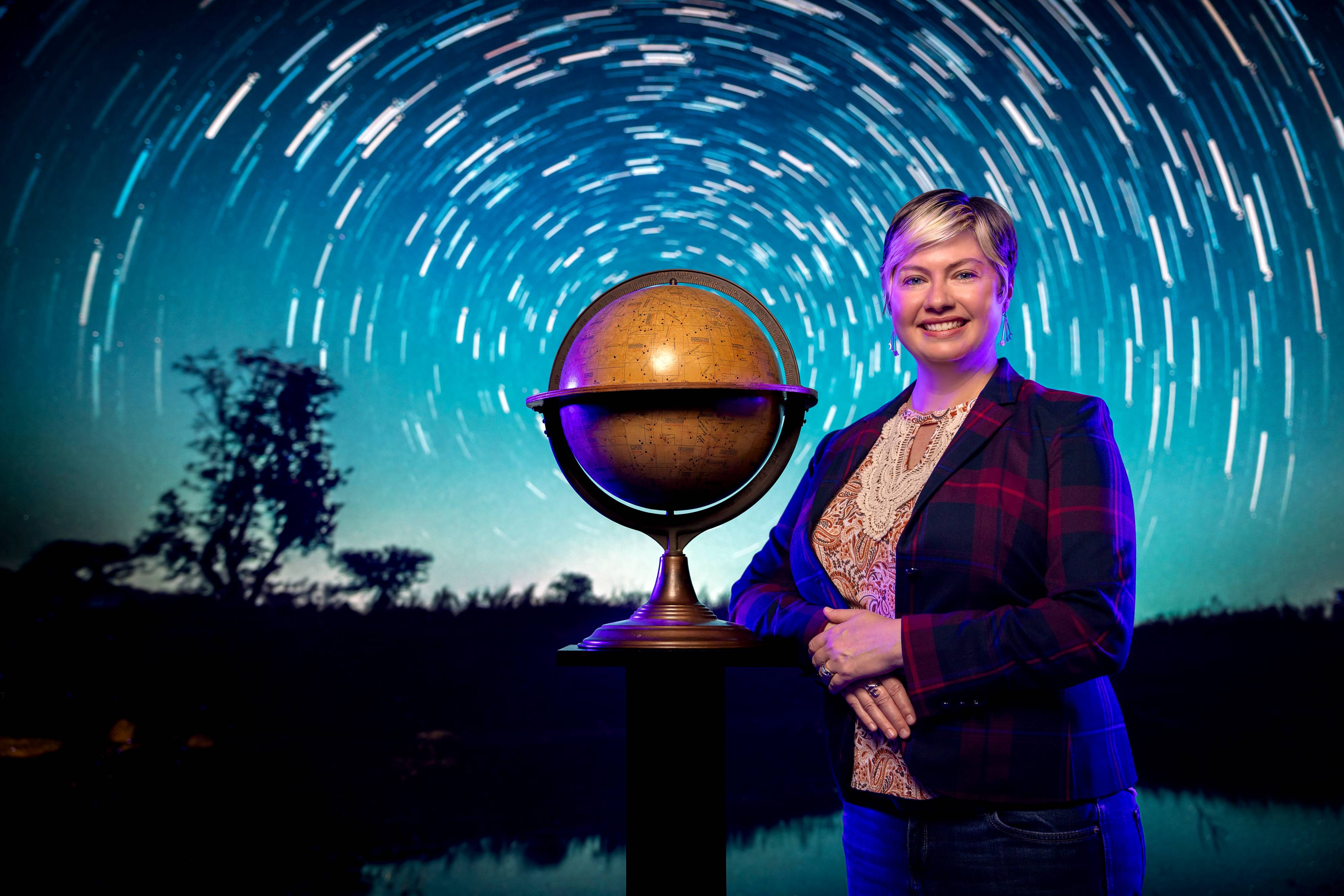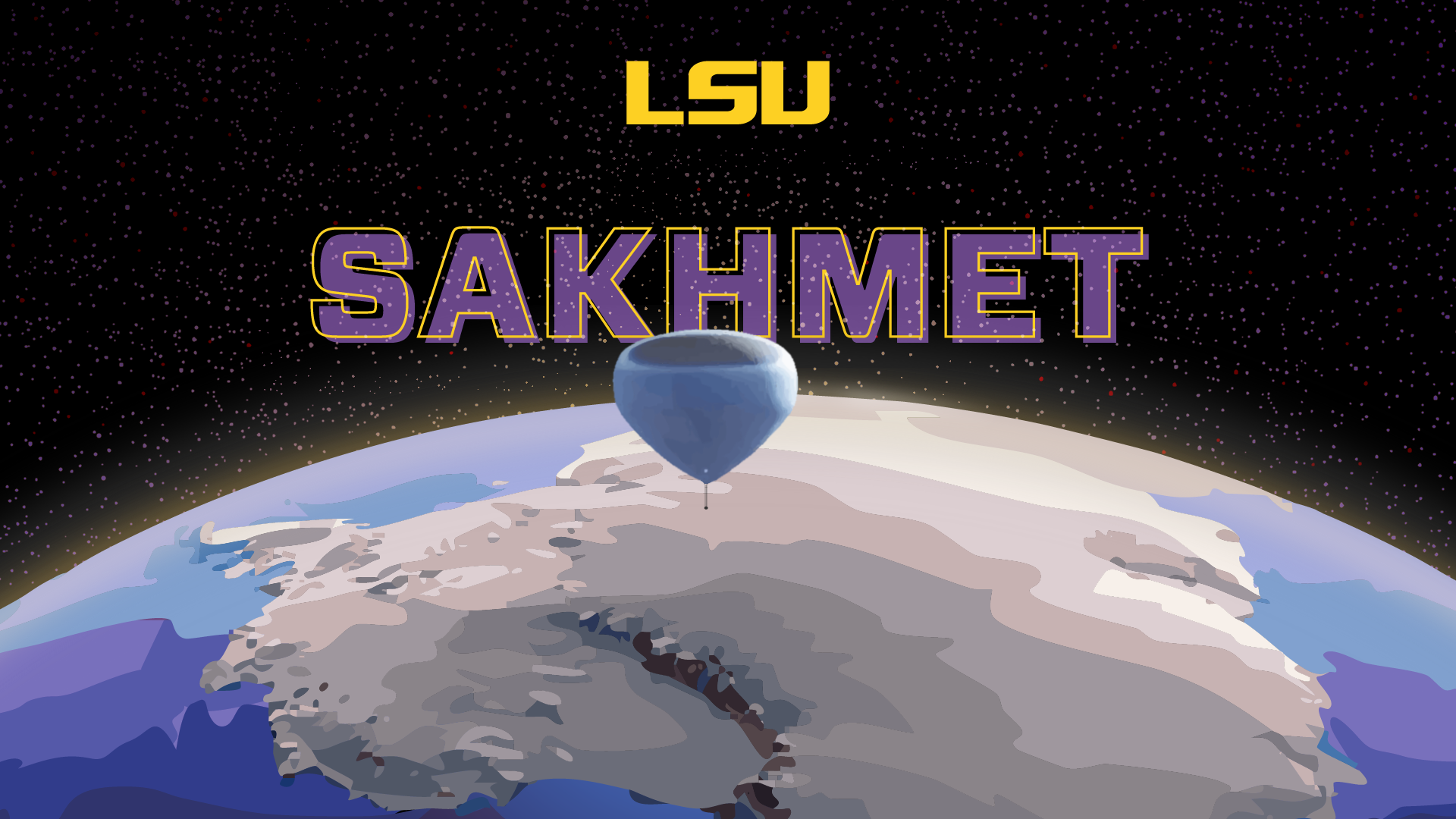From Louisiana to the Stars: How LSU’s Dr. Natalie Hinkel is Unlocking the Secrets of the Universe
March 28, 2025
When exploring the mysteries of the universe, Natalie Hinkel is at the forefront — right here in Louisiana.
As a planetary astrophysicist at LSU, she leads groundbreaking research on the composition of stars and their connection to the potential habitability of exoplanets.

LSU's Natalie Hinkel is leading a team of researchers who are working to better understand the Milky Way and small, Earth-like planets beyond our solar system called exoplanets.
Now, she and her team of researchers are developing a state-of-the-art near-infrared telescope to study M-dwarf stars — one of the most prevalent yet least understood types of stars in our galaxy. That team includes universities nationwide, including LSU, the Southwest Research Institute, Indiana University, the University of Arizona, and the University of Texas at Austin.
In this Q&A, Hinkel shares how this research could revolutionize our understanding of the Milky Way and small, Earth-like planets beyond our solar system called exoplanets.
What is the inspiration behind your research?
I love to look at big-picture questions. The core of my research is that I study what stars are made from, namely the raw elements, to understand the history of their formation and what it could also mean to the potential habitability of planets that they host or exoplanets. I run the largest database of stellar composition in the world, called the Hypatia Catalog. It’s a project I’ve worked on for about 15 years and a service I provide to the larger community, including NASA. I use the data within the Hypatia Catalog to see big-picture patterns and try to understand stars' behavior in our solar neighborhood. So not only does this impact our understanding of the galaxy, but it contributes to the question of planet habitability. Stars and planets are made at the same time and from the same material. It’s not possible to measure the composition of an exoplanet because they are so incredibly far away. Yet, a planet's interior and surface makeup is incredibly important to the planet's habitability, whether it’s human or some other kind of life. Therefore, we use the composition of the host star as a proxy for the make-up of their planets, as a way to understand whether planets are truly rocky, like the Earth, or whether they might be overly dense (like larger super-Mercury) or a water-world or gas-planet (like a mini-Neptune).
I go over a lot of these ideas in my 2017 TEDxNashville talk on “We’re All Stardust — And Why That Should Make You Feel Awesome.”
“ I think there is something inherent in nearly all people that drives them to understand where they came from and to know whether we are alone in the galaxy or not. That idea of exploration and wonder is like an ember just waiting to be fanned and catch fire. ”
What is the problem your research and discovery hope to solve?
M-dwarf stars are the smallest stars that can live for an incredibly long time. Most of the light coming from M-dwarfs is near-infrared, so the stars look red – as opposed to our yellow Sun, which gives off mostly visible or optical light – which is why M-dwarfs are often referred to as “red dwarfs.” M-dwarfs make up about 75% of all stars in the galaxy and are an important key to understanding big galactic questions. They are also the next best place to discover small, Earth-sized planets because it’s easier to find a small planet around a small star.
However, we know very little about the composition of M-dwarf stars and their planets because it’s very difficult to observe M-dwarfs from the ground. Basically, the Earth’s atmosphere blocks out almost all the near-infrared light coming from M-dwarf stars. While it would be nice to use space-based telescopes (like the James Webb Space Telescope), none of them have the high resolution that we need for our observations. It’s like having a phone camera with a low number of pixels – you can’t really make out the details or understand what you are seeing.
The whole point of our mission is to make the mysterious M-dwarf stars better understood. By flying a high-resolution, near-infrared telescope around Antarctica, we will be able to get above the Earth’s atmosphere to observe M-dwarf stars in a way that’s never been done before by anyone anywhere. We will measure 12 important elements in about 300 stars, 11 of which host small exoplanets. The results from our mission will truly revolutionize our understanding of the Milky Way and small Earth-sized planets.
What is the impact of the research?
Our mission will help us figure out how we (the solar system, Sun, Earth, and living creatures) got here and whether we are alone in the galaxy. I think there is something inherent in nearly all people that drives them to understand where they came from and to know whether we are alone in the galaxy or not. That idea of exploration and wonder is like an ember just waiting to be fanned and catch fire.
Why are traditional ground-based and space telescopes not always ideal for this type of research?
Traditional ground-based telescopes are set up to look at stars that are similar to the Sun, which requires observing visible or optical light. M-dwarfs can only really be observed in the near-infrared. Unfortunately, the atmosphere is made of a lot of water and carbon dioxide, which blocks a lot of the infrared light from reaching the ground. As a result, we only have small windows in the infrared where we can look out and observe astrophysical objects — which means we end up missing out on a lot of what happens in the infrared unless we observe from space.
As I mentioned above, space-based telescopes don’t have the resolution that we need to measure the composition of elements inside of stars. Those satellites can only give us very vague ideas of the composition, which doesn’t really help us understand the deeper questions about how stars in our galaxy have lived and died or the make-up of planetary surfaces and interiors.
How does a balloon-borne telescope work?

SAKHMET (Spectroscopic Abundances to Know the Heritage of M-dwarf Environs through Time) will utilize a state-of-the-art near-infrared telescope to study M-dwarf stars.
The telescope is attached to a gondola, which itself is connected to a large zero-pressure balloon. The gondola has a pivot on the top of it, where reaction wheels allow it to rotate and point at specific stars. An Antarctic balloon gets carried by the circumpolar winds that go around the South Pole, meaning that the balloon will travel in a circle back to where it was launched within about 15 days. Our hope is to get two revolutions around the pole for a 30-day mission.
What could this technology mean for the future?
Our work to design and build our instrument will be the first of its kind. It will really open up possibilities for other science about planets, stars, and perhaps other galaxies that are currently inaccessible from the ground. Honestly, I think our work could enable a whole sub-field in astronomy that has been forced to look at the universe through small windows — our plan is to take down the whole wall!
What NASA grant are you applying for, and how will the funding be used?
I’m applying for the NASA Pioneers grant. It is a $20M grant that will go towards paying our team members to build the gondola, fabricate parts of the telescope, buy other parts of the telescope that have already been built (“off the shelf” components), then pay team members to put everything together (or integrate) into one whole unit. Our science team uses a technique called spectroscopy to measure the amount of particular elements in a star, or the stellar abundances. So we will be paying them to investigate the near-infrared region we’ll be observing to find the key elemental and molecular lines to determine the abundances, then create a pipeline to allow us to measure the composition of the M-dwarfs very quickly after they have been observed. We will also be doing a test flight in New Mexico about a year before the science flight in Antarctica to ensure everything works!
Why did you choose to do your work at LSU?
LSU has a great history of ballooning, including with student projects! I thought it made sense to combine expertise and experience.
What’s next?
We’ve applied for this mission a few times and we are going to keep applying until we win. My team and I very much believe in the importance of the work that we’re doing. And since missions are expensive and complicated – which means they need a long lead-time, so we are in it for the long-haul.
Whenever our mission gets funded, I plan on setting up a number of ways (website, social media accounts, etc.) so people can engage with what we are doing and why.
Anything else you want people to know?
I’m so incredibly proud of my multi-institutional team. We have been working together for about 5 years now to flesh out this mission proposal idea, do the necessary background work, explore the trade space, and make whatever modifications we can to improve the instrument and science. On top of that, I truly enjoy working with everyone — the meetings are fun, something I look forward to, and we have a good time while we get the work done. Many team members are people that I now consider my dear friends, and honestly, I count myself lucky that I get to work with them. And, of course, I can’t wait to go to Antarctica together to fly our mission — that’ll be an amazing time.
Next Step
As we build teams that win for Louisiana, the nation, and the world, LSU is putting our state and its citizens on firmer footing for a brighter tomorrow — one win at a time.


